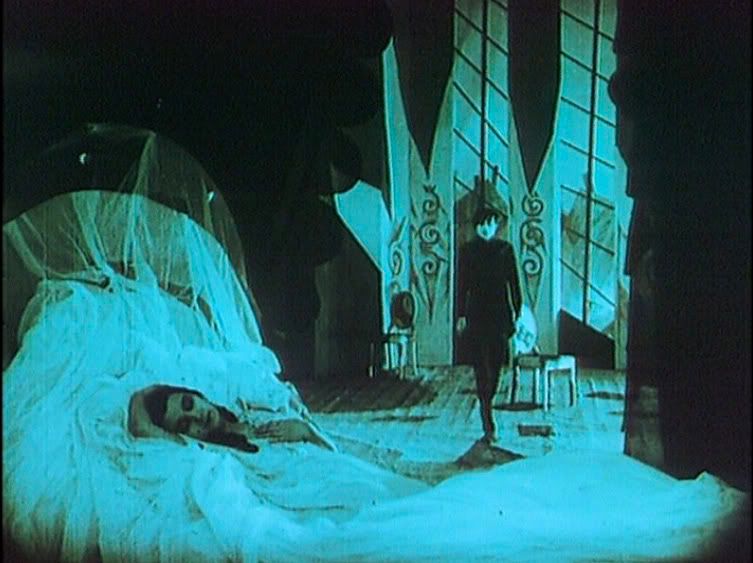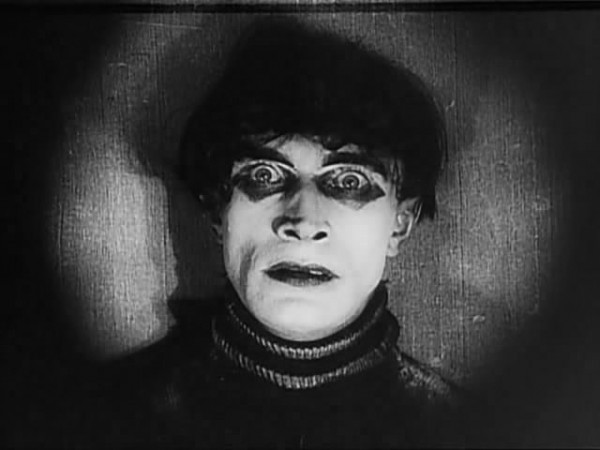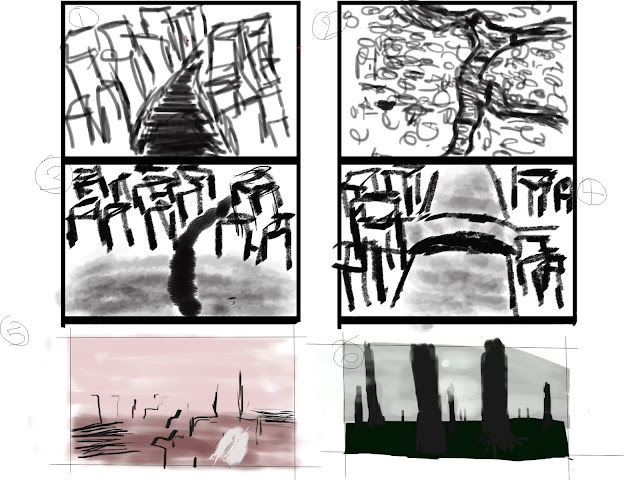 |
| Numbers 7 - 9 are of Octavia in black and white digital paintings. Number 10 is a rural shot of Anastasia in colour. |
Wednesday 30 September 2015
Invisible cities 7-16
Monday 28 September 2015
Maya Tutorial 2 - Ray Gun
I found this tutorial rather enjoying as it showed me different methods to complete tasks that I would do differently. This will gradually improve my modelling time and my overall ability. I also found the toon setting very interesting as I previously was unaware of it and could have used it in previous work.
Saturday 26 September 2015
Space Oddities: Das Cabinet Des Dr. Caligari Review
When watching Robert Wiene's 'The Cabinet of Dr. Caligari (1920)' there is always one thing that stands out to the viewer. This is the use of the abstract painted set used throughout the film. All of the background sets where two dimensional paintings which are wonderfully designed using slanted walls, distorted perspective and many other styles that you would never find in a modern day film. The use of these sets combined with the black and white camera, which was not used by choice rather as a necessity at the time, immediately gives the viewer an eerie feel which represents the genera (horror) that they are watching.
Another way in which The Cabinet of Dr. Caligari draws in viewers and their attention is quite simply the story line. The use of the characters within the story line was portrayed brilliantly by Weine, building suspicion on some characters, and having others seem as a hero to some aspect such as one of the main characters Francis (Friedrich Feher). But from watching the film you can see how the use of the story line, which you at assume to be a simple and predictable story, the characters develop and there are twists and turns that had not even been considered by the viewer.
 |
| Fig 1. |
Along with Wiene's use of abstract sets he is also considered one of the pioneers for what is now modern day horrors. You notice this from the use of shots that when viewing they immediately send you back into your memory and scenes of a similar nature of recent films come flooding to mind. One of these iconic scenes is when we can see Jane (Lil Dagover) asleep in bed. While this is happening at the front of the shot in the background you see Caesar (Conrad Veidt), Dr. Caligaris somnambulist, creep into her room and kidnap her (fig 2). When watching this the viewer can tell that Weine is trying to convey that the only people who can see what is going on in the background is the viewer. A technique rarely, if ever, used before within a feature film. Where as when watching modern horrors we can see this technique used in near enough every one in some way be it small or large. We can see this point backed up from Rodger Eberts review of the film from where he said '"Caligari" is said to be the first example in cinema of German Expressionism, a visual style in which not only the characters but the world itself is out of joint. I don't know of another film that used its extreme distortions and discordant angles'
 |
| Fig 2. |
Another way in which Wiene draws in the audiences attention is due to the over exaggerated movements of the actors within the film. The use of these exaggerations helps to compensate for the lack of dialogue in the film. When scene that should have conversations between two characters in you could almost tell what was being said between them just from the visual movements and over exaggerated reactions. The use of these exaggerated movements and the obscure camera angles gives the viewer a real feel of what the character is feeling at the time. We can see this several times from close up shots of Dr. Caligari (Werner Krauss) you can see the look of mischievous and suspiciousness on the characters face portrayed using up to several different facial expressions within one shot. What also draws the viewers into these shots is Wiene's use of outlines and boarders. He would have shots which appear to be zooming into the characters face (fig 3). At times it was a normal shot with everything blacked out apart from the characters face giving the illusion of zoom and taking all of the viewers focus and putting in to this one character.
 |
| Fig 3. |
 |
| Fig 4. |
The combination of the abstract set, with bending buildings and sharp shadows, and the use of obscure camera shots along with exaggeration and twists and turns in the story line there is no trouble seeing how this classic horror has helped paved the way for horror films to come with very distinguishable moments that can give flashbacks of horrors to any viewer.
References:
Quote - Rodger Ebert - http://www.rogerebert.com/reviews/great-movie-the-cabinet-of-dr-caligari-1920
Images:
Fig 1 -https://karamelkinema.files.wordpress.com/2014/01/dc00.png?w=640&h=500
Fig 2 - http://i.ytimg.com/vi/imyo9E7GbIU/maxresdefault.jpg
Fig 3 - http://ludditerobot.com/wp-content/uploads/2015/04/caligari14.jpg
Fig 4 - https://1001films.files.wordpress.com/2010/08/vlcsnap-2887143.png
Friday 25 September 2015
Invisible City Thumbnails 1-6
These are my first 6 thumbnails for the invisible cities project. Thumbnails 1-4 are of Anastasia, thumbnail 5 is of Armilla and 6 of Baucis. I'm not happy with my thumbnails. I have found it difficult trying to portray the idea I have of the cities in the thumbnails. I think this is due to a lack of my drawing skills and I have also found getting used to the graphics tablet within Photoshop fairly difficult.
With the thumbnails I tried to do the first four as simple quick black and white sketches, but from is it made all of the buildings appear as towers which is not how I imagined it. I then decided to try and to move into colour to see if that would help me convey my ideas clearer. Unfortunately with this I found myself trying to focus on the colours too much and spent most of my time worrying about that. I am going to keep working on my drawing skills and Photoshop skills and will be drawing thumbnails every day.
Influence Map
Here are two influence maps from Italo Calvino's descriptions of the cities within 'Invisible Cities'. The aim of this influence map is to convey my initial ideas for what I think some of the cities will look like. There are certain aspects of some of these images that really stand out to me as something that could be straight from the book. The main two cities that stood out to me while creating this was Anastasia and Diomera. I found these two cities easily visualised and they reminded me of real life places and objects that immediately came to mind when reading through the text.
Thursday 24 September 2015
Maya Tutorial 1 - Egg Cup
Today I worked on the first Maya tutorial that was set to us. I have previous experience and feel comfortable within the software. But just from this one tutorial I learnt of tools that I was previously unaware of. The revolve tool is one of the tools which I hadn't used before and it makes modelling simple objects so much easier and less time consuming.
 |
| This is the first egg cup that I made when using the revolve tool. This is before I went back to the side view to clean up the object and make the shape look more realistic. |
Monday 21 September 2015
Digital Paintings
Today we started off our Photoshop lessons with digital paintings. These are the two which I completed within class.
Sunday 13 September 2015
Summer Project
These are the 101 sketches from the images provided and also the in depth drawings. Overall I am not too pleased with these drawings. My drawing skills need to be improved on greatly and I will be working on this to try and see an improvement as soon as possible.
Subscribe to:
Posts (Atom)
































